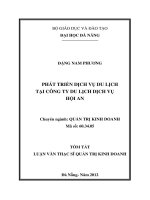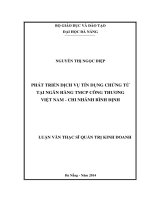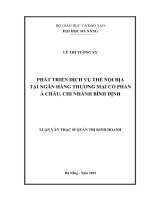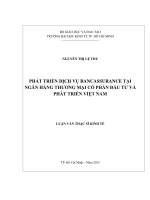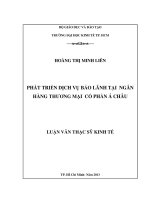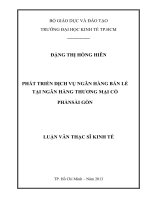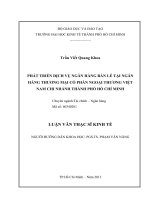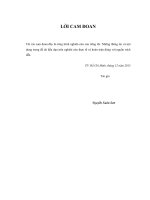Luận văn thạc sĩ phát triển dịch vụ ngân hàng cho khu vực nông thôn tại công ty dịch vụ tiết kiệm bưu điện
Bạn đang xem bản rút gọn của tài liệu. Xem và tải ngay bản đầy đủ của tài liệu tại đây (2.02 MB, 114 trang )
V IE T N A M N A T IO N A L U N IV E R S IT Y , H A N O I
H A N O I SC H O O L O F B U SIN E SS
D uong D anh C hung
D E V E L O P IN G R U R A L B A N K IN G S E R V IC E S A T V IE T N A M
P O S T A L SA V IN G S S E R V IC E C O M P A N Y
M a jo r : B u s in e s s A d m in is tr a tio n
C o d e : 60 34 05
M A S T E R O F B U SIN E SS A D M IN IS T R A T IO N T H E SIS
S u p e rv is o r: D r .T r a n P h u o n g L an
H a n o i- 2 0 1 0
TABLE OF CONTENTS
C o n ten ts
Page
ACKNOW LEDGEMENTS
V
L IS T O F A C R O N Y M S
vi
L IS T O F T A B L E S A N D G R A P H S
viii
A bstract
ix
T ó m tắt
xi
C H A P T E R 1: I N T R O D U C T I O N
1
1.1. P ro b lem
1
1.2. O b jectiv es & A im s
5
1.3. Thesis Q u estio n s
6
1.4. A p p ro a c h e s
7
1.5. S co p e o f w o rk s
7
1.6 . Significance
8
1.7. E xp ec ted R esults
8
1.8. Structure o f the thesis
9
C H A P T E R 2: L I T E R A T U R E R E V I E W
10
2.1. D efinition o f rural b an kin g
10
2.2. C o m p o n e n ts o f rural banking
11
2.2.1. P ro d u cts & services
11
2.2.1.1. S avings
11
2.2.1.2. Loans
12
2.2.1.3. M o n ey transfer
14
2.2.2. S ervice providers
14
2.2.3.1. Form al service providers
14
2.2.3.2. Sem i-form al service providers
15
2.2.3.3. Informal service providers
16
2.2.3. C u sto m e rs
17
2.3. Specific characteristics o f rural banking
18
2.3.1. H ig h transaction cost
18
2.3.2. H ig h risk
18
2.3.3. H ig h illiterate rates o f the custom ers
19
2.4. Factors affecting developm ent o f rural banking
20
2.4.1. G o v e rn m e n t Policies
20
2.4.2. E xcessiv e and increasing dem and for rural banking
23
2.4.3. C ultural and custom s issues
25
2.5. Trends in develop ing the rural banking services
27
2.5.1.
R ural custom er need orientation
27
2.5.2.
In nov ative distribution channels
27
2.5.3.
B u ild in g on existing netw ork o f distribution
28
2.5.4.
M in im iz in g risks
28
2.6. Existing success m odels in developing rural banking
29
2.6.1. L arg e netw ork o f distribution
29
2.6.2. P ro d u ct m anag em ent & low cost o f operating
32
2.6.3. Risk m a n ag em e n t
34
2.7. C hapter rev ie w
37
C H A P T E R 3: ANALYSIS ON VIETNAM RURAL BANKING MARKET
38
3.1. V ietnam poverty profile
38
3.2. D em and for form al rural banking services has never been met
39
3.2.1 C alculatio n o f un-banked rural population
39
3.2.2 T h e w a y s rural households deal w ith the absence o f formal
banking services
40
3.3. Rural b an k in g providers
43
ii
3.3.1. F orm al rural b an k in g providers
44
3.3.2. Semi form al rural banking providers
47
3.3.
49
3. Informal rural banking m echanism s
3.3.3.1. F orm s o f operation
49
3.3.3.2. A d v an tag e s
51
3.3.3.3. D isad v an ta g es and negative im pacts
51
3.4. M acro policies on rural banking
52
3.4.1. The State P olicy on agriculture, countryside and farm ers (Policy
o f “T am n o ne”
52
3.4.2. G ov ernm ental D ecree (No 41 /2 0 1 0 /N D -C P ) on credit policy for
agriculture and rural developm ent
54
3.4.3. Subsidies for loans from V B S P and V D B
55
3.5. Effect o f rural inhabitant's culture & custom on their banking behavior
56
3.6. A pply model o f P E S T analysis
57
3.7. C hapter review
59
C H A P T E R 4: V I E T N A M P O S T A L S A V IN G S S E R V I C E
62
4 . 1 . O v erview o f V ietnam Postal Saving Service C o m p a n y (V PS C )
62
4.2. V N P o st needs an alternative business line to offset the stagnant
outlook for traditional postal services
65
4.3. C hallenges facing V ietnam postal savings service
66
4.4. A nalysis on strategic adv antages o f V PS C in dev eloping rural banking
services
66
4.4.1. F avorable con ditions from G ov ernm en t policies
66
4.4.2. V ision o f L ead ers in developing rural banking services
67
4.4.3. P rom inent n etw ork & technical capacity
69
4.4.4. L ow transaction cost
70
4.4.5. C onv en iences and trust recognized by rural custom ers
71
4.4.6. A dv antag e in prevention o f risk from asym m etric inform ation
74
iii
4.5. A pply S W O T analysis
74
4.6. C hapter review
79
C H A P T E R 5: R E C O M M E N D A T I O N
81
5.1. Products offered
82
5.1.1. A ccum ulation savings account
82
5.1.2. Small loans
84
5.2. Solutions should be taken into consideration in designing product &
process
86
5.2.1. F or savings service
g^
5.2.2. F or small lending service
gg
5.3. M od el o f operation
94
C O N C L U SIO N
95
Reference
100
iv
ACKNOWLEDGEMENTS
I w o u ld like to express my grateful to Lecturers and staff from H SB M B A program
for their know ledge and support during my M B A course at Hanoi School o f
Business, especially to Dr. Tran Phuong Lan for her excellent supervision, advices
and com m ents.
I also w ant to show m y thankful to my colleagues for their discussions and
assistances.
A nd last but not least, I m ust express my deep gratitude to m y beloved family, all
those w h o w ere alw ays besides me, for their encou rag em en t and supports.
H a Noi, O ctober 2010
D u o n g D anh Chung
LIST OF ACRONYMS
BIS
Bank for International Settlements
cw u
C o m m u n e W o m e n ’s Union
CCP
C o m m u n e Cultural Point
D PT
D istrict Post & T elecom m unication
ESBG
Euro Savings B ank Group
FU
F a rm e rs ’ U nion
GSO
G eneral Statistic Office
IFAD
International Fund for A gricultural D evelopm ent
ILO
International L abor Organization
LIH
L o w -in co m e H ousehold
LUC
L and-use certificate
LPC
Local P e o p le ’s C om m ittee
MFI
M icrofinance Institutions
NGO
N o n-G ov ernm en tal O rganization
UN
U nited N ations
UNDP
U n ited N ations D evelopm ent Program s
PCF
People's Credit Fund
PC
P e o p le ’s C om m ittee
PO
Post O ffice
ppr
P rovincial Post & T elecom m unication
ROSCA
R otating Savings and Credit Association
ROSLG
R otating Savings and Lending G roup
SBV
State B ank o f V ietnam
SO
Social O rganization
VBARD
V ietnam Bank o f A griculture and Rural D evelop m en t
VBSP
V ietnam Bank for Social Policy
VDB
V ietnam D evelop m ent Bank
V FU
V ietnam F a rm e rs ’ U nion
V N P ost
V ietnam Post Corporation
vi
VNPT
V ietn am Post & T eleco m m u n ica tio n G rou p
VPSC
V ietnam Postal S av in gs
Service C o m p a n y
V PS S
V ietnam Postal S avings
Service
VWU
V ietnam W om en 's U nion
WB
W orld Bank
W SB I
W orld Savings Bank Institute
LIST OF TABLES AND GRAPHS
T a b le/G ra p h
N am e o f T able/G rap h
Page
Table 2.1
S u m m aries profiles o f the participating savings banks
w ith its large outreach to custom ers in rural areas
30
Table 3.1
T h e Poverty Rate under the national poverty line for
period 2006 -2009
39
T able 3.2
C alculation o f un-banked rural population
40
T able 3.3
T y pology o f Credit Sectors and Lending Share to
H ouseholds
43
Table 3.4
N u m b e r o f outstanding Savings accounts opened w ith
44
m a in formal rural banking services providers
Table 4.1
V P S C ’s business results in recent years
64
G raph 4.2
Postal savings service inside V N P o s t’s organization &
operation
65
viii
A bstract
D E V E L O P I N G R U R A L B A N K IN G S E R V I C E S A T V IE T N A M
P O S T A L S A V IN G S S E R V IC E C O M P A N Y
Student: D u o n g D a n h C hung - M B A , 2008-2010
School o f Business, V ietnam National University. H a Noi
Supervisor: Dr. T ran P h uo ng Lan
O ctober 2010, 101 pages
V ietnam is am o n g the poor countries in the world, w ith 72% o f population residing
in rural a re a s'. Like m ost other developing countries, rural households' access to
financial services is very limited. The nature o f this limitation is particularly country
specific, co m m ercial
banking services are only for the top
10- 2 0 %
o f the
population. O n the other side, those in extrem e poverty, the bottom 1 0 -2 0 % o f the
p o pulation are the targets o f very large socio-political directed lending program s via
V ietnam B an k for Social P olicy2. This leaves the vast m iddle m arket, about 70% o f
the population, those m ainly living in rural areas alm ost entirely un-banked.
In the con text o f this absence o f appropriate form al banking services, many rural
household s have to rely on informal banking services for savings and borrowing.
T hese inform al ban k in g service providers offer no paym ent capacity, nor flexible
savings opportunity. T he real attraction o f these m echanism s o f informal banking is
the possibility o f qualifying for credit. H ow ever, it is very insecure and there have
been m a n y scandals. B ut perhaps most w orrying o f all is the fact that rural
househ olds are te m p ted into borrow ing at very, very high interest rates co m p o u n d
interest
per
day
is not
uncom m on.
This
fact
means
that
1%
rural
c o m m u n ities have been thirsting for essential basic formal banking services, and o f
1 G SO : S ta tistic a l Yearbook 200H
WSBI: W orking w ith S avings Banks in order to double the num bers o f savings accounts fo r the
p o o r (P roject w ith Vietnam P o sta l Savings Service Com pany, 2010, pa g e 2)
ix
course, they afford to pay for it.
With about 70% o f the population those mainly living in rural areas almost entirely
un-banked, there is a trem endous opportunity for existing financial institution like
V ietnam Postal S avings Service C om p any (V PS C ), with its netw ork o f post office
already outreached the rural areas, to develop and to capture rural banking market
share.
This thesis analyzed limitations to access to formal banking services in the rural
areas, show ed out its im pact on rural households' livelihoods. B ased on that, the
thesis recognized the business opportunity in developing rural banking services for
VPSC. T he thesis also aim ed to propose appropriate solutions that V PS C should
take into consideration while designing its rural ban king products & process.
The data for thesis were collected from various sources - both prim ary and
secondary. P rim ary data w ere collected from interview s and observation at selected
villages in the N o rth o f V ietnam w ithin the fram ew ork o f an on going project
financed by W orld Savings B ank Institute (W S B I) and Bill & M elinda Gates
F oundation facility for savings banks in order to double the nu m ber o f savings
accounts for the poor. Secondary data was gathered from do cum entary sources in
the form o f reports, records and review o f literature.
x
T óm tắt
PH Á T T R IẾ N DỊCH V Ụ NGÂN HÀNG CHO KHƯ
vực NÔNG THÔN TẠI
CÔNG TY DỊCH v ụ TIẾT KIỆM BƯU ĐIỆN
Sinh viên: D ư ơ n g D an h C hung - M B A , 2008-2010
K hoa Q u ả n trị K in h D oanh, Đại học Q uốc gia H à N ội
G iản g viên h ư ớ n g dẫn: Tiến sĩ Trần P hư ơn g Lan
T háng 10 năm 2010, 101 trang
V iệt N a m thuộ c nh ó m các nước đang phát triển trên thế giới, với 72 % dân số sinh
sống tại k h u vự c nông th ô n 1. G iống như hầu hết các nước đ an g phát triển khác, tiếp
cận dịch vụ tài chính của các hộ gia đình nông thôn rất hạn chế. Bản chất của sự hạn
chế này m a n g y ếu tố đặc thù, xuất phát từ việc các ngân hàng thư ơng mại chỉ phục
vụ k h o ảng
10- 2 0
% dân số thuộc phân khúc dân số có thu nhập cao2. Ở phân khúc
ngược lại, nh ó m có thu nhập rất thấp, nghèo đói chiếm kho ản g
10
đến
20%
dân số
thuộc đối tư ợ n g p hục vụ của các chư ơng trình cho vay hỗ trợ của Chính phủ thông
qua N gân h à n g C hính sách xã hội. Đặc thù này dẫn đến thực trạng phần lớn dân cư
thuộc nh ó m có thu nhập thấp và trung bình, chiếm kho ản g 70% dân số và đa phần
sinh sống tại khu vực nông thôn chưa được đáp ứng các dịch vụ ngân hàng.
T ro n g bối c ả n h thiếu v ắng các dịch vụ ngân hàng cung cấp bởi các định chế ngân
h àn g chín h thức, rất nhiều người dân có thu nhập thấp và trung bình ở khu vực nông
thôn buộc phải lựa chọn sử dụng các hình thức cu ng cấp dịch vụ ngân hàng không
chín h thức. C ác hình thức này không cung cấp các dịch vụ thanh toán và các sản
p h ẩm tiết k iệm linh hoạt. Đ iểm cơ bản hấp dẫn của hình thức này là sự dễ dàng
trong việc đáp ứ ng các điều kiện cho vay. Tuy nhiên, cơ chế cung cấp dịch vụ ngân
1 To n g cục T h ố n g kẽ: N iên giám thốrì% kê 2008
ỉỉiệ p h ộ i n g â n h à n ẹ íiẽt kiệm thế giới: N hóm d ự án với các ngân hàng tiết kiệm nham nhân đôi so
lư ợ n g tài kh o à n tiêỉ kiệm cho ngư ời rtẹhèo (D ự án tài trợ C ông ty D ịch vụ Tiếí kiệm Biỉĩỉ điện Việt
Nam. 2 0 ỉ 0, tra n g 2)
xi
hàng không chính thức thực sự không an toàn cho cả nhà cung cấp dịch vụ và khách
hàng. V à điều đáng lo ngại nhất đối với hình thức này là việc người đi vay phải
chấp nhận m ức lãi suất “cẳt cổ ”, có thể lên đến m ức 1% lãi kép/01 ngày. N h ư vậy
chứng tỏ người dân nô n g thông đang rất cần đến các dịch vụ ngân hàng cơ bản và
họ có đủ khả năng chi trả các chi phí hợp lý cho các nhà cung cấp dịch vụ chính
thức.
Với qui m ô 7 0 % dân số V iệt N am , trong đó đa phần sống tại khu vực nô n g thôn
chưa được sử dụ n g các dịch vụ ngân hàng thiết yếu, rõ ràng là cơ hội rất lớn cho
C ông ty D ịch v ụ Tiết kiệm bưu điện (T K B Đ )-vớ i m ạng lưới bưu cục rộng lớn đã
phủ kín tới các khu vự c n ông thôn-phát triển và ch iếm lĩnh thị trư ờn g ngân hàng
bán lẻ cho khu vực nô n g thôn.
Bản luận văn này p h ân tích những hạn chế trong tiếp cận các dịch vụ ngân hàng tại
khu vự c nô n g thôn, chỉ ra nhữ ng ảnh hưởng của dịch vụ ngân hàng đối với sinh kế
của ngư ời dân nôn g thôn. Trên cơ sở thực tế nhu cầu thị trường, bản luận văn xác
định cơ hội kinh doan h trong việc phát triến và cung cấp dịch vụ ngân hàng cho khu
vực nô n g thôn cho các định chế tài chính như công ty D ịch vụ Tiết kiệm B ư u điện.
Đ ồng thời, bản luận văn đề xuất n h ũ n g giải pháp phù họp cần được cân nhắc áp
dụng trong quá trình thiết kế sản phẩm, thiết kế quy trình và cung cấp dịch vụ.
xii
C H A P T E R 1:
IN TR O D U C TIO N
1.1. Problem
1.1.1. Majority o f rural households are un-banked
Since the period o f innovation, G overnm ent has been carrying out num ero us
policies to build a m o d e rn V ietnam ese rural in order to raise rural h o u s e h o ld s ’
income and to im prove rural co m m u n ities’ living standard. So far, rural areas have
attained rem arkable achievem ents in term s o f econ om ic grow th and poverty
reduction. The pov erty rate in rural areas decreased from m ore than 30% in the
years o f 1990s to 16.2 % in the year o f 2 0 0 8 1. H ow ever, there has been a large gap
betw een rural and urban areas. The social econom ics existence shows out that m any
essential basic services for rural com m unities have not been met. A m o n g these
services, access to formal banking services-an essential basic service, is severely
limited.
There has been an ou tstanding fact in banking industry that, w hile the urban areas
seem h av in g b eco m e saturated with banking services, M ajority o f co m m u n ities
residing in the rural areas are still un-banked. There has been grow ing dem an d for
banking services in the rural areas, especially the credit needed for production and
consum ption. N evertheless, the existing formal banking sector does not satisfy these
dem ands. This ab sen ce o f formal banking supply bring about m an y b orrow ers have
to turn to informal loan sources (private m oneylenders, p a w n b ro k e r’s, relatives,
rotate savings & lending groups, etc.) to meet their financial needs. It has been
estim ated that only 3 0 % 2 o f the farmers in rural V ietnam have had access to formal
credit and about only
6% 3
o f the population m aintaining bank accounts.
1 Voice o f Vietnam: 2008/200812/100718. vov
Previor
I 7’.S’(
Survey on micro credit, 2 0 0 page 3
3 Citibank: Survey on Best Practices in Postal Banking, 200~
1
A question should be raised and answ ered by formal financial services provider is:
W hat are the main reasons that lead to the state o f m ajority o f rural households are
still un-banked. Is this because rural households do not afford to pay for formal
banking services or because formal banking services are not conform able to rural
h o u seh o ld s’ w ishes?
1.1.2. A s the limitation on expanding and maintaining rural network o f bank
branches, existing banks & financial institutions can not reach out to cover the
rural markets
It may be explained that market im perfections (such as asym m etric information,
poor social & eco no m ic conditions in the rural a re a s ...) are am on g reasons for the
absence o f formal rural banking services that leads to the lack o f access to services.
H ow ever, the dev elopm en t o f financial technologies, such as credit rating system,
joint-liability group lending or lending through partnership with social/inform ation
interm ediaries may enh ance information availability and reduce the risk to the rural
banking service providers.
So, w hat are the m ain reasons?
B y observing the realistic Supply & D em and side for b anking services in the rural
a re a s 1, especially the existing & flourishing o f the unofficial m arket for credit
service in the rural areas, w e can find out the m ain reasons that limit the formal
rural banking services to outreach the rural m arket are not only turned around the
rural banking m arket imperfections. These main reasons are:
a) The first m ain reason is the constraint in exp anding and m aintaining system o f
bank branches o f co m m ercial banks & financial institutions. Recently, banks are
planning to expand their system o f branches to close the distance to rural customers.
'. WSDI: Working with Savings Banks in order to double the numbers o f savings accounts
fo r the poor (Project with Vietnam Postal Savings Service, 2010)
H ow ever, these plans can not be realized in the short period o f time. The reason is
this e x p an d in g plan will cost banks very huge initial investm ent for offices. In
additional, it will bear num erous operational expenses for m aintaining a w idespread
branch system in the rural areas.
b) T h e second m ain reason is the high transaction costs for executing small scale o f
banking transaction. This is because the nature o f low level o f econom ic activities,
low p opu latio n density that result in dispersed dem and for services that causing
high inform ation collection. These conditions m ake rural b anking offering less
attractive for profit-driven financial institutions.
c) T h e third m ain reason related to seasonality and co-variance o f agricultural and
farm produ ction activities, which lower margins and increase the risks related to
rural banking business.
d) T he fourth main reason com es from the custom ers characteristics. M ost o f the
rural custom ers possess low education background. T h ey also cannot provide
standard collateral against the loan as required by the financial institutions.
D ue to ab ov e un favorable conditions for developing rural banking services, so far,
formal b ank ing service providers have only concentrated their capability on serving
urban m arkets. U ntil the urban banking m arket com petition becom in g more and
m ore hard, ban k s are planning to m ove their concentration from only the urban to
the rural m arket. H ow ever, this m ovem ent can not be realized in the short term due
to difficulties com e from the huge initial investm ent needed to build up platform for
service offering.
1.1.3. Inform al market fo r banking service, especially fo r credit service in the
rural areas has been existing & flourishing
As the particularly country specific, com m ercial banking services are only for the
top 1 0 -2 0 % o f the population. O n the other side, those in extrem e poverty (the
bottom
1 0 ~ 2 0 %>)
are the targets o f very large socio-political directed lending
program s via the V ietnam B ank for Social P o lic y 1. This leads to existing situation
that there is a big gap in outreach to those rural V ietnam ese households neither well
enough o f f to use com m ercial banks nor so poor that they qualify for G ov ernm entsubsidized financial programs.
As a result, m ajority rural households are excluded from the formal banking
services and in alm ost cases, they have to rely on the informal banking services at
very high costs for accessing the services. The co nsequence is: D em and for formal
banking services by rural com m unities has never been met.
1.1.4. Vietnam postal savings service has an extensive transaction network. This
network's capacity has not been taken fu ll advantage and can be the most
appropriate and competitive channel to provide rural banking service
In the context o f capital-scare o f V ietnam econom y, by a D ecision o f Prim e
M inister, V ietnam Postal Savings Service was launched since 1999 in order to
create a n ew channel for m obilizing idle fund for national develop m ent investment.
Since its launching, V P S C has been proved to be a potential channel in offering
rural banking services. With its unique characteristics, offering savings & paym ent
services based on the existing network o f public post offices, V ietnam Postal
Savings Service posses an extensive netw ork o f transaction offices that could reach
up the level o f c o m m u n e areas. O ver the 10 years operation, the existing V ietnam
Postal S avings S ervice has made good progress in filling the absence o f rural
banking services. H ow ever, so far, this netw o rk ’s capacity has not been taken full
advantage. U ntil now , the services offered through the postal savings offices are
still very m o n o ton ous, only am on g simple individual savings products. It m eans that
V PSC has barely begun to deliver its potential. This is a w aste o f national resources
for eco no m ic and social development.
1 WSBI: Working with Savings Banks in order to double the numbers o f savings accounts
fo r the po o r (Project with Vietnam Postal Savings S e n ’ice, 2010)
4
1.2.
O b jectiv es & A im s
The aim o f this thesis is to provide a deep analysis on how to take full potential and
current com p etitive advantages o f V ietnam postal savings service C o m p a n y in
developing and o ffering rural banking services to m eet the grow ing dem an d for the
services by rural com m unities.
To realize this aim, the thesis recognizes the key objectives as follows:
a) To explain the absence o f formal rural banking services on contrary to the
existing & flourishing o f the informal banking services. T hese situations then w ould
give exp lanatory w hy the rural com m unities are generally excluded from the formal
banking sector;
b) To en hance the understanding that the rural households, even the p oor and lowincom e h ou seh olds do have dem and for banking services, especially that they can
afford the com m ercial cost o f formal banking services;
c) To specify the potential and com petitive advantages o f V ietnam Postal savings
service C o m p a n y in developing and offering rural banking services;
d) To explain ho w to m ake use o f the existing international success m odels in
developing rural b an k in g services, as well as the innovative b anking technologies
and solutions should be em ployed by V PS C to enable rural households gain access
to its formal b ank ing services;
e) To prove that: O ffering rural banking services th rough V P S C can m eet multi
objectives at the sam e time;
•
To help m ajority com m unities residing in the rural areas easily access to
banking services;
•
To take full advantage o f the existing netw ork o f postal savings post offices;
5
•
To increase the effectiveness o f using the existing netw ork and to improve the
business result o f VPSC.
t) To pro pose appropriate solutions that V PS C should take in to account while
designing rural ban k in g products & process to ensure double targets at the same
time:
•
Being co nfo rm ity w ith the unique characteristics and operation m echanism o f
V ietnam P o stal S aving Service;
•
Being co nfo rm able and satisfied to rural clients’ dem and.
g) To system atize argum ents on the rural banking services that needed by rural
banking service providers as well as banking policies m akers in the process o f
developing, m a n ag in g and controlling banking activities.
1.3. T hesis Q u estio n s
There are so m e m a in questions raised by the thesis. A t the sam e time, the thesis is
going to find out the answ ers for these questions. T he questions are:
a) W h y bank s did not pay m uch attention on the rural m arket while these areas
have alw ays been in the situation o f serious shortage o f credit & other
ban k in g services?
b) W h at are the negative impacts o f the existing & flourishing o f the unofficial
credit o v er the rural areas and by what w ay to replace it?
c) W hat kind o f service features that the service providers m ust pay much
attention on & by w hat solutions to operate the rural b an king services that
cou ld guarantee limiting the risks, reducing the operation cost and ensuring
the profitability?
6
1.4. A p p r o a c h e s
The goals o f the thesis are realized by em ploying both theoretical and empirical
analyses. The theoretical analysis consists o f literature review and analyzing on
related subjects. The literature reviews are the desk-based research which uses
various sources o f secondary data and inform ation such as books, journals, w orking
papers, reports from the library, internet and discussions.
T he em pirical an alyses consist o f analysis on existing international success models
in dev elo p in g and offering rural banking services. Case studies analysis based on
desk research an d use secondary data that are draw n from surveys such as Survey
on living standards in V ietnam -V ietnam Living Standards Surveys 2006; Survey on
m icro credit by P revior & V ietnam Postal Savings Service in 2007; General
Statistic O ffice - Statistical H and book 2008; V ietnam Statistical Y earbook 2008;
W S B F s Project with V ietnam Postal Savings Service, 2010: W orking with Savings
B anks in order to double the num bers o f savings accounts for the poor; World
D ev elo p m en t Indicators data base, W B, 2009;
1.5. S co p e o f w o r k s
T he thesis w orks focus on:
a) C o n d u ctin g research on rural banking m arket in general, V ietnam ese rural
b anking m a rk e t’s specific characteristics in particular;
b) C o llecting data and analyzing the Supply side & the D em and side for rural
b an k in g services;
c) Specifying the pressing need for banking services in the rural areas;
d) E x am in in g the realistic effectiveness and the practical achievem ents o f rural
business and p roving that rural household business can afford to pay for formal
ban k in g services;
7
e) S pecifying V P S C ’s specific characteristics, com petitive advantage and practical
capacity. B ased on that to identifying the potential and com petitive advantages
o f V ietnam Postal Savings Service in offering rural banking services;
f) S ug gesting appropriate products offered and p roposing key solutions to ensure
the feasibility, effectiveness, risk control and profitability o f dev eloping offering
rural banking services through Postal Savings Service.
1.6. S ign ifican ce
The thesis will contribute to know ledge and understanding o f rural banking
services’ im portance role in the process o f d ev eloping rural econom y. Especially,
the thesis expresses the reality o f need for rural b an king services in general, the
need for loan by rural h o useholds’ small-scale econ om ic activities in particular.
It is expected to contribute a feasible solution to take full advantages and convert
the potential o f the existing Postal Savings Service System into business results. At
the sam e tim e, it further realizing the original purpose o f launching the Postal
Savings Service by the G overnm ent.
1.7. E xpected R esults
The first exp ected result o f this thesis is to identify the business opportunities in
developing and offering rural banking through V ietnam Postal S avings Service
system.
At the sam e tim e, the second expected result is to propose concrete p roducts and to
specify solutions to operate the services that guarantee limiting the risks together
w ith ensuring the profitability.
The thesis d o cu m en t m ust include draft description o f product offered, key features
and solutions to be taken into consideration w hile designing products & designing
procedures in offering and operating the services so that it is con form ab le to the
8
rural m arket d e m a n d as well as the unique characteristics o f V ietnam postal savings
service.
1.8. S tru ctu re o f the thesis
The thesis is structured into 5 chapters including this chapter.
C hap ter 2 rev iew s the relevant literature relating to rural banking in general, its
com ponents and specific characteristics in particular.
C hap ter 3 focuses on the rural banking market in Vietnam. This C hapter show s out
the excessive dem an d for rural banking services. The chapter also analyses the
supply side and specifies the main constraints for access to formal rural banking
services an d the m ain characteristics o f agricultural activities that rural banking
service providers m ust pay concern.
C h ap ter 4 introduces V ietnam Postal Savings Service C om pany, analyses on its
unique,
specific
characteristics
and
operation
m echan ism
that
created
its
com petitive ad v an tag es in developing and offering rural banking service.
In C h a p ter 5, the thesis goes to suggestion o f products offered and to propose
appropriate solutions that should be taken into consideration while designing
products & process to ensure the services safety and effectively.
9
C H A P T E R 2: L IT E R A T U R E R E V IE W
2.1. D efin ition o f rural banking
Rural b ank ing is a form o f financial services that provide solution to the essential
basic financial needs o f the com m unities residing in the rural a re a s 1.
In natural, rural b an king has its ow n objectives as follows:
a) P overty alleviation objective: to uplift the m ass o f population residing in the
rural areas w ho are currently below the poverty line by extending credit to the
sm allest scale eco no m ic activity;
b) F inancial objective: involve increasing the accessibility o f banking services to
the rural p oor and households in a com m ercially sustainable manner.
M ajority o f the rural population in developing countries depends on agriculture for
survival. A s a eco n o m ic unit, rural households need b an king services to accum ulate
assets; to finance production activities; to cov er consum ption; and to execute
paym ent transactions. Rural financial institutions thus often provide services for
activities related to agriculture, such as micro accum ulation savings for future
spending, input supply, production, or distribution and m arketing o f agricultural
products. Beside, rural financial
institutions also provide co nsu m er credit to
purchase g oods such as furniture, appliances and loans for em ergency cash need in
case there are unaffordable situations such as medical care, expenses for education,
w edding cerem ony, and so on.
As pointed out above, providing banking services to the agricultural sector involves
specific
challenges
related
to
sector-specific
risks
and
to
other
specific
characteristics o f agricultural activities, such as seasonality and long maturation
processes. Loans for agricultural production or livestock breeding usually have
longer term s than those for trade or small industry. In addition, rural households
InfoR esoitrces - I-i/cus X<>2, Sep
Acccssiug F in a n c ia l S e r v ic e s in R u r a l A rea s. P a g e J
10
need financial services that are adapted to the agricultural cycle, such as savings
schem es to provide cash for the season in between harvests, or transfer schemes for
remittances for m igrants w ho leave the rural areas for seasonal work.
2.2. C o m p o n e n ts o f rural banking
2.2.1. P rod u cts & services
Rural banking services mainly involve providing essential basics financial services
such as savings, loan and m oney transfer to rural com m unities.
2.2.1.1. Savings
The rapid eco n o m ic g row th over the past few years has im proved living standard o f
rural h ou seholds significantly. Thanks to this, there are increasing dem ands by rural
households to accum u late assets and m anage risk. Savings is one o f important tool
for that. S avings assist the rural population in reducing vulnerability to risks,
planning m o re reliably for the future and saving for up co m in g investments, as well
as sm o othing out irregular income flows and covering unexpected expenses.
The p ro m o tio n o f savings habit o f rural population can help sustain a solid rural
savings base, w hich provides a significant basic for rural investm ent and rural
econom ic d ev elo p m en t as it helps alleviate the rural are a s’ depen den cy on state
investment. E vid en ce show s that the accum ulation o f savings help creates a internal
capital base that m akes households business less depend ent on external capital and
more resistant to capital market fluctuation.
The question n o w is w hether rural population in developing countries can actually
save?
M an y research sh o w s that the global poor and rural households require savings
instrum ents as dearly as credit. M oreover, deposits are the best w ay to fund b an k s’
lending activities. A sound financial institution is about building sound and
transparent institutions that m ediate local funds to build local econom ies. In the
11
view o f the bank, to protect and encourage rural savings entail not only civic duty to
the more vuln erable rural population, but it is also an expression o f a moral
obligation to help rural com m unities to use accum ulated resources wisely.
A ccording to various studies, the rural areas provide substantial deposits to the
banking system o f the country. Such mobilization o f deposits in rural areas could be
m uch greater if the banks' presence in these areas w as bigger.
H ow ever, m a n y researches show ed out that, rural households still have limited
access to savings products that meet such assets accum ulation and risk m anagem ent
needs. S avings m obilization is critical for financial m arket developm ent. The failure
o f many credit projects particularly in the rural financial sector indicates that
savings m obilization has invariably been neglected or has played a minor role.
Savings will benefit a larger proportion o f rural poor than credit provision.
Innovative savings instrum ents and institutions w hich pay greater attention to
deposit and savings m obilization are therefore crucial elem ents o f rural banking
market developm ent.
2.2.1.2. Loans
Loans for p ro d u ctio n and consum ption are crucial elem ents that enable rural
households to m ake investments, seize econom ic opportunities, and purchase
agricultural inputs and w orking capital. Short term con sum ptio n or em ergency loans
can help h o useho ld s to avoid difficult situations that might have forced them to sell
an asset. H o w ev er, loans are not alw ays favorable: som e p oor b orrow ers experience
difficulties in rep ay in g their debts, due either to circum stances beyo nd their control
(e.g. sickness, theft, natural disasters) or to a lack o f kn ow ledge and w rong
investment strategies.
Traditional b an k in g sector cannot reach millions o f poor for w hom small loans
could m ake h ug e differences. There are several reasons for this. M ost o f the poor
are rural, and they are dispersed. They have low education levels. As a result,
12
